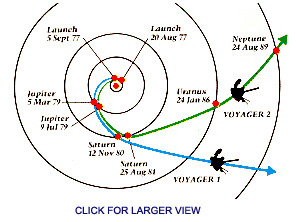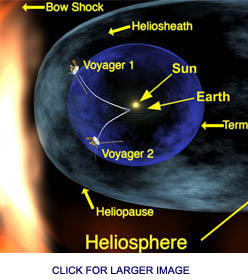The Voyager Space Craft SCIENCE Kit Fact Sheet
The Illustrated Voyager SpacecraftView a large image depicting all of the Voyager Spacecraft's major components and scientific instruments: view online as GIF image, or download as PDF.Highlights of Voyager's Tour of the Outer Solar SystemThe twin unmanned Voyagers were launched separately late in 1977 in time to take advantage of a rare alignment of the outer planets. By using the gravity and orbital speed of the outer planets to help accelerate the spacecraft, it was possible to save fuel and make a "grand tour" of the outer solar system in a reasonable length of time.JupiterIn March and July, 1979, Voyager 1 and 2, respectively, made highly successful encounters with the giant planet Jupiter. They took close-up images of the turbulent, clouded atmosphere, and made startling discoveries, such as the existence of Jupiter's tenuous dust ring. They saw volcanoes spewing molten sulphur hundreds of kilometers above the surface of Io, one of Jupiter's four planet-size moons. Most of its surface is is covered with freshly fallen sulphur snow. Large craters on the ancient surface of Callisto date back thousands of millions of years to the time of its early formation. A craterless sheet of water-ice forms Europa's smooth surface. Numerous fault lines scar the surface of Ganymede.SaturnStealing speed from Jupiter's orbital momentum via its gravity, both Voyagers were hurled toward encounters with the Saturnian system in November, 1980, and August,1981. The magnificent rings were found to be incredibly complex. Although Saturn's colors are more muted than Jupiter's, atmospheric storms were visible, and equatorial windspeeds approach 1,500 kilometers per hour. A thick atmosphere with a surface pressure measured at one and a half that of Earth, hid the surface of Saturn's largest moon, Titan.
Although Saturn's colors are more muted than Jupiter's, atmospheric storms were visible, and equatorial windspeeds approach 1,500 kilometers per hour. A thick atmosphere with a surface pressure measured at one and a half that of Earth, hid the surface of Saturn's largest moon, Titan.
UranusSpeed obtained from Saturn whipped Voyager 2 toward encounter in the Uranian system. During its 5-year cruise period, virtually all of the spacecraft's on-board software was redesigned, making Voyager 2 a very modernized machine upon arrival at Uranus in January, 1986. Ten moons, and several additional rings were discovered. The five previously-known moons are mostly made of water-ice and rock, their surfaces very dark, and all very different from one another. Cliffs 20 kilometers high, and other features never before observed, were seen on small Miranda.NeptuneCarefully targeted to take advantage of Uranus's gravity and motion, Voyager 2 was put on course for the closest encounter ever: a plunge only 4600 kilometers above Neptune's cloudtops, with a gravity assist to Triton five hours later. Ten years to the day after Saturn encounter, after fully twelve years in flight, the aging Voyager 2 made an impeccable final encounter in August, 1989. Neptune, an unresolved smudge in the best ground-based telescopes, displayed an Earth-size Great Dark Spot similar in appearance to Jupiter's Red Spot. Bright cirrus-like clouds were seen high in the atmosphere, casting shadows into the hazy, deep-blue atmosphere below. Six moons were discovered, and three complete but clumpy rings were seen. Neptune's large, bright moon Triton was confirmed to have a thin, hazy atmosphere of nitrogen. Active geysers were observed spewing nitrogen and soot from Triton's nitrogen-ice covered surface.The HeliopauseVoyager 1 was deflected north of the ecliptic plane during its encounter with Saturn and Titan. Voyager 2 is on its way south of the ecliptic. Together, they will continue to sample the environment in the far reaches of the solar system, making their findings known daily.In mid 1993, Voyager 1 first sensed radio signals coming from the edge of the Sun's influence, called the heliopause, where the out-rushing solar wind meets the incoming stellar wind.
In late 2004, Voyager 1 crossed beyond the Sun's Termination Shock, where the solar wind goes subsonic.
The Voyager Project and the Deep Space Network are managed for NASA by Caltech's Jet Propulsion Laboratory, Pasadena, California. Images courtesy JPL/NASA.
| SCI HOME PAGE | CATALOG | HOW TO ORDER | GREAT SPACE LINKS |
|
